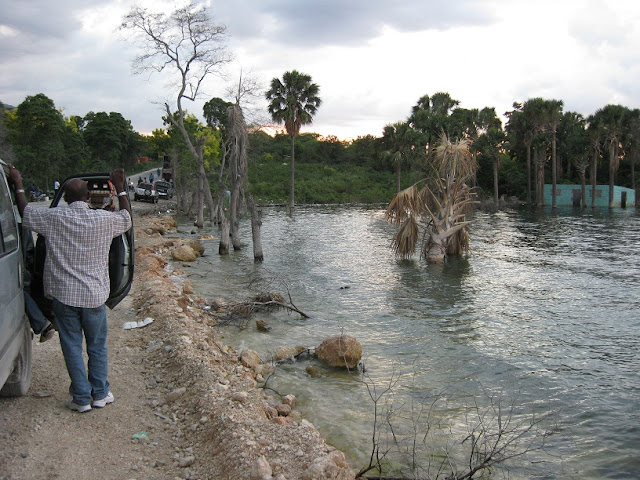It turns out I'd built up my apprehensions about Haiti more than I’d needed to. Don't get me wrong, Haiti is in a bad way. But my anxiousness about going there was unnecessary. The poverty and filth was similar to the kinds I've seen in other underdeveloped countries. It was just broader in Haiti. We saw it everywhere. When we entered the country from the Dominican Republic, we did so on a dirt road. The main highway leading west into Port-au-Prince – the Haitian interstate, as I called it – was barely wide enough for two cars, had no lines painted on it, and was speckled with holes, ruts, and bumps.
In Port-au-Prince, so much still lay in disrepair. The unemployment number I’ve heard quoted for the country as a whole is 80 percent. Thousands of men and women in the city and in Gresier, the suburb where we stayed, shuffled through the streets or sat near their houses and tents with nothing to do, while scores of construction projects remained unfinished or not yet started. The government certainly can’t afford to pay for the public works that are needed, and the international aid organizations that crowd the country aren’t hiring. The Haitian economy was ailing long before the earthquake, and now it’s nearly dead. Is there such thing as an economic defibrillator? Our host, Daniel, asked what I thought. I didn’t know what to tell him. Set up a protectionist economy, to encourage local businesses? I don’t know. Ask someone else.
In addition to the completely jobless, thousands more people displayed fruits, vegetables, DVDs, and clothes, enormous heaps of clothes, all along the sidewalks in town. These people are counted among the unemployed, because this type of informal-sector hawking cannot be relied upon for income. “In Haiti, there are more vendors than buyers,” said Daniel.
Like other poverty-stricken cities, though, there were areas where systems and people were working. Port-au-Prince is not all tent cities, potholes, rebar, and broken cinderblock. It has a handful of clean, modern shopping centers and even a few restaurants. Up on the hill, in Pétionville, the wealthy still have their comfortable houses. Now and again, I even saw men dressed in suits. Still, the poverty and brokenness tend to blot out the bright spots. The giant market by the port, set up with help from the Venezuelan government, is a filthy mess of used clothing and discarded banana branches. The city’s canals are filled with Styrofoam, plastic bottles, and sludge. Hundreds of thousands of people still live in tent cities. The UN and most of the other aid organizations that seem to be around every corner are only trying to patch up the country’s damages, not get to the root causes of poverty.
After two days of seeing so much darkness in Haiti, I was feeling like the whole place should be scrapped and started over. Then a couple of patches of light started to shine through. Our hosts showed us a site where a school was being built by a nonprofit organization set up by an ambitious 24-year-old Louisiana girl who partnered with locals in the endeavor. Later, I was encouraged even more when we visited with the board of directors for the organization I work for. I was inspired to meet and hear optimistic words from this group of Haitian leaders who are sacrificing time and energy to set up and oversee the development of long-term initiatives that do more than merely put a Band-Aid on Haiti’s troubles. I couldn’t stop their enthusiasm from rubbing off on me at least a little bit.
I know I’m biased, but I really do think my employers have set things up in the best way possible to bring about lasting improvement. The only discouraging thing is that it will probably take a generation or two before any substantial change is visible. The plan in Haiti, as it has been in the other countries where we’re more established, is to start small, by educating children and ensuring them a positive upbringing by providing food, medical care, and other necessities. The hope – and we’re starting to see this become a reality in the Dominican Republic, where we’ve been working for over a decade – is that these kids will grow up to become doctors, teachers, etc., who find gainful employment and give back to their communities to help future generations out of poverty. Maybe then, 10, 20, 30 years down the road, Haiti will have a crop of new leaders who can employ and educate others, creating a positive sort of domino effect. It’s a slow process, but long-term change always is.
























